
We’ve come up with a fairly clever design which allows us to easily manipulate the relative stiffness in the torsional mode, as well as the lift mode for a bridge section. It’s also easy to adjust for the structural density and all those things.
Every bridge deck has its unique dynamic behaviour, so it’s quite easy to hone in on the dynamic properties of that particular section. That improves the accuracy of the model in terms of dynamic behaviour. It’s quite advanced in that regard. This helps expedite the process of actually setting up the dynamic model. It reduces the lead time and obviously the cost associated with the test.
There’s a lot of benefits from having such an
advanced test rig…
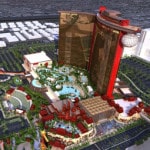
Windtech Consultants provided their wind engineering expertise to the largest Las Vegas Strip development in 10 years. The multi- billion resort, located on the Las Vegas strip, was designed by the architectural, planning and design company, Steelman Partners LLP. Once completed, the development has been tipped to revamp the Las Vegas strip and create a new center of gravity in the northern part of the world-famous Boulevard.
The China-themed resort, which is being developed by Genting Group, is expected to open in early 2019 and will include over 3,000 hotel rooms, meeting and convention space, numerous authentic Asian restaurants, over 100,000 square feet of gaming space and a 30,000-square foot lake as part of the Chinese garden. The project is expected to create over 13,000 direct and indirect jobs.
The complex structure, essentially involving three connected towers to create an elongated form in plan, required the engineers at DeSimone to generate a set of influence coefficients to enable Windtech to determine the amount of load transfer between the three substructures that interconnected to create this unusual tower form. Testing was performed both with and without the effect of the future planned tower buildings nearby. In addition, out testing program accounted for the effect of staging of the subject tower, which required different influence coefficients. For each of the three cores, the design loads were determined from the envelope of the four scenarios, which consist of two stages and two configurations of surrounds.
Windtech also undertook a study of the net design pressures acting on the façade and other lightweight cladding, also accounting for the four different scenarios.
An extensive wind environment study was also carried out, which covered both the street level and the communal recreational areas across the expansive podium.
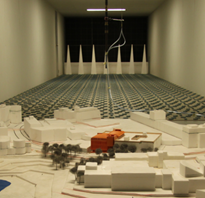
A common problem for building designers and managers is not achieving the level of thermal comfort in line with expectations. This can be due to a number of factors including correct establishment of comfort criteria and accurate modelling of both wind and solar effects. The inability to account for these complex flow effects in urban environments is due to the limitations of computational modelling when considered in isolation. Windtech Consultants accounts for these effects through the use of wind tunnel modelling to accurately account for the wind-driven component at the boundary conditions during the computational modelling process. This significantly improves the accuracy and reliability of the expected thermal conditions for the end user.
Windtech has demonstrated this modelling process on many past projects and thermal environments, including the award-winning Global Change Institute building in Brisbane. Windtech has also been requested to reanalyse the thermal performance for a number of past projects after inadequate attempts by other consultants, as in the case of the Pepsi Green Field Factory development in Dubai.
CASE STUDY – AWARD-WINNING GLOBAL CHANGE INSITUTE, BRISBANE
The progressive and forward-thinking development, part of the University of Queensland, won the ‘2016 Queensland Rider Levett Bucknall Development of the Year’ award. Additionally, it was a finalist in 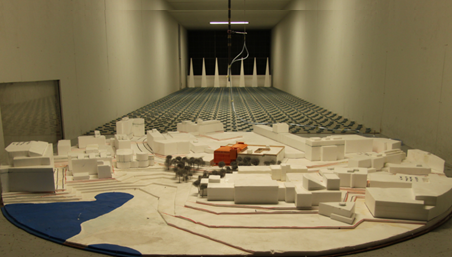 the 2016 Property Council of Australia National Innovation and Excellence Awards.
the 2016 Property Council of Australia National Innovation and Excellence Awards.
Figure A: Photograph of the Wind Tunnel Model used for the study of the Global Change Institute
Windtech Consultants is proud to have assisted in the development of the award-winning Global Change Institute in Brisbane, having been the wind consultant for the project.
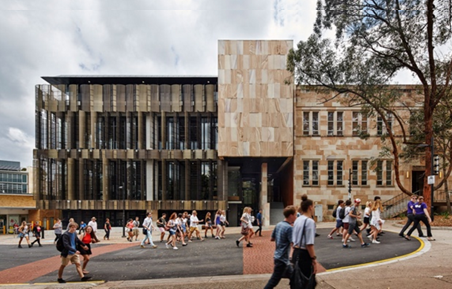 Figure B: Photograph of the Global Change Institute at completion (Source: The Urban Developer 2016)
Figure B: Photograph of the Global Change Institute at completion (Source: The Urban Developer 2016)
Windtech utilised their hybrid analysis technique to account for the effect of thermal comfort through improved natural ventilation. The purpose of such studies was to reduce the reliance upon mechanical ventilation and encourage the use of natural ventilation, utilising both thermal and wind-drawn airflow through the building. Through this means, an integrated, sustainability-focused and optimised design is achieved. Windtech were also about to account for the effect of the sun-tracking rotating louvres located at the front of the structure, protecting against the sun and glare.
CASE STUDY – PEPSI GREEN FIELD FACTORY, DUBAI
Windtech was also appointed to reanalyse the natural ventilation design of the Pepsi Green Field Factory in Dubai. Due to energy restrictions for the site and power needed for plant processing, a means for reducing 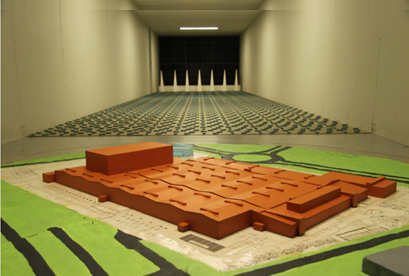 the high demands from mechanical ventilation was sought. Windtech Consultants conducted a hybrid wind tunnel and computational model study to find a solution. The site’s location and exposure to prevailing winds and internal heat loads were able to be accounted for with the location of external openings recommended to improve natural ventilation to maintain suitable internal conditions. This removed the need for mechanical ventilation, assisting in the overall project’s design.
the high demands from mechanical ventilation was sought. Windtech Consultants conducted a hybrid wind tunnel and computational model study to find a solution. The site’s location and exposure to prevailing winds and internal heat loads were able to be accounted for with the location of external openings recommended to improve natural ventilation to maintain suitable internal conditions. This removed the need for mechanical ventilation, assisting in the overall project’s design.
Figure C: Photograph of the Wind Tunnel Model used for the study of the Pepsi Greenfield Factory
Figure D: Concept design image of the Pepsi Greenfield Factory (Source: PMG 2016)
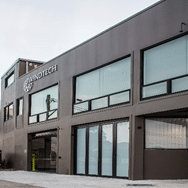





Commissions Its Third Wind Tunnel to Better Service Growing Demand
Windtech Consultants has recently relocated to its new headquarters, which incorporates its third state-of-the-art wind tunnel facility, making it one of the largest such facilities in the world. This significant milestone also happens to coincide with the company’s 25th Anniversary, so there are many reasons to celebrate.
The decision to establish the third wind tunnel at its Global Headquarters in Sydney enables the company to cater for growing demand. The decision to have all the wind tunnels located at its head office is driven by the need to maintain quality control over testing procedures by the specialist senior staff. Windtech offers its clients access to witness the testing either in person or live via a webcam.
The company was established in 1991 focusing solely on wind engineering services and operating out of a warehouse in the Sydney City Fringe suburb of Camperdown. For the past seven years Windtech has been growing at a steady pace and currently employs over 50 wind engineers plus admin staff. Windtech has attracted high calibre engineering staff and has over time developed a high level of expertise in all areas relating to wind and buildings. Currently, Windtech Consultants, an Australian based global wind engineering firm with projects from all around the world, has branch offices in Melbourne, Singapore, London, New York, Abu Dhabi and Mumbai.
In addition to their regular studies of wind loads on tall or large building structures and façade cladding, they have developed expertise in a broad range of related areas, including air quality, wind noise, natural ventilation and wind entry, to name a few. Besides wind tunnel modelling, Windtech offers desktop methods where applicable, including CFD based flow and thermal modelling. Other studies include thermal performance rating, daylight, solar access, solar light and heat reflectivity studies and stack effects.
One of Windtech’s three wind tunnels has been configured to facilitate the testing of bridge deck sections, due to its ability to generate very low background turbulence by means of three air straightener sections and a large plenum. This reduces the time and cost of modifying the flow in the wind tunnel to generate the low background turbulence in comparison to other methods.
Director, Tony Rofail and Associate, Dr Nick Truong are on the Australia and New Zealand Standards Committee for wind actions on Structures. Tony Rofail, who in 2001 was involved in the drafting of the original Australasian Wind Engineering Society’s Quality Assurance Manual for Wind Tunnel Testing has recently worked on the draft of the update to the same document, expected to be released later this year. Tony Rofail is also on the CTBUH Committee for Wind Engineering and Design of Dampers.
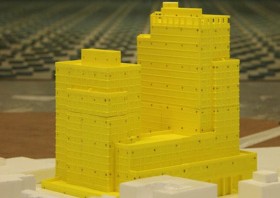
Windtech Consultants provided their wind engineering expertise to two residential towers located at Hallets Point in Queens, New York. The Harlem River is situated to the immediate north and west of the two buildings which also share a podium. Windtech worked alongside The Durst Organization, Dattner Architects and the façade engineers, Vidaris to carry out initial desktop pedestrian wind environment assessment to provide early design input. More detailed wind tunnel studies were then carried out to optimize the cladding design for wind pressures and a pedestrian wind environment comfort.
Results from the pedestrian wind environment comfort study indicated wind conditions for the local surrounding area were expected to remain similar to the existing conditions. However to achieve more favorable wind conditions in the trafficable outdoor areas for the intended use, Windtech worked with the architect to develop a strategic mitigation strategy which included awnings, densely foliating trees and other measures to enhance these wind conditions.
The façade cladding pressure study was undertaken to determine and optimize the 50 year return period design wind pressures acting on the cladding of the development when compared to purely code based estimates. Testing was performed using one of Windtech’s three boundary layer wind tunnels, which each have a 10ft wide working section and has a fetch length of 46ft. Due to several other developments being proposed nearby, testing for this project was performed with the effect of only the existing surrounding buildings and with the addition of the proposed nearby developments. This ensured that a worse-case scenario was considered for the future wind conditions the development will encounter.